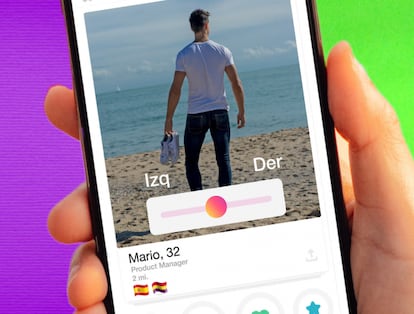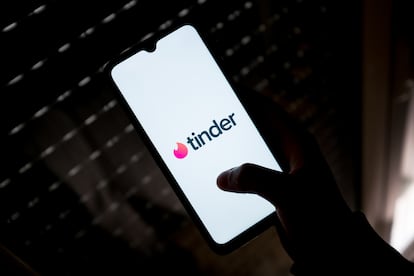The hunt for a Tinder rapist who convinced his victims to remain in the dark
Spanish police arrest man suspected of conning at least 10 women into sexual encounters by posing as someone else, always meeting in darkness to hide a skin disease that could identify him

Everything was dark. Not even a silhouette could be made out in that room shrouded in darkness. The woman and the man had met after months of conversations on the online dating app Tinder. He had asked that the encounter take place in complete darkness to ensure “sensory contact to heighten the senses so you can let yourself go.” But there was a moment when she noticed something didn’t seem quite right. She turned on the flashlight on her cellphone, briefly illuminated his face and saw that it was the not the same as the photograph on the profile she had been chatting with for so long. He, conscious of the skin disease that afflicted his face and aware he had been discovered, became nervous and sexually assaulted her. When she was able to flee, the woman went to the police and reported the incident. Operation Escamas (flaky skin) had begun.
This first witness made her statement last February and investigators quickly sensed she was not the only victim. Detectives from the Spanish police’s Family and Women’s Care unit faced an enigma, as they often do in their line of work. An assailant with no name and no face, with a fake profile on social media, with only the briefest of glimpses afforded to the witness, which was not sufficient to identify him. The threads of the investigation were thin but little by little the police tied them together until they found him.
On his Tinder profile he used photographs he culled from the internet of young men “who were neither handsome nor ugly,” according to police sources. This led his victims to believe they were talking to someone real. “He invented a double life, which he kept up for months until he completely won the trust of the women,” said the same sources. Only after a long time spent chatting would the proposition come: a date in complete darkness to heighten the senses, and always at the woman’s home. On occasion, when the woman wasn’t comfortable meeting under those conditions, he would book a hotel room and send them the bill, which was always much higher than the actual cost of the stay.
It was an incredibly difficult task to track the assailant down. The man, a 43-year-old Spaniard, had no known address and moved from job to job. He was sometimes violent towards his victims and often waited until they had gone to the bathroom or were not looking to steal money or other valuable items. Afterward, he would block them on all social media so they had no way of contacting him again.

Suspect’s arrest was tip of the iceberg
His arrest did not signal the investigation but instead led the police to discover they had only uncovered the tip of the iceberg. Officers detained him when he turned up to start a new job in a Madrid suburb, one of the many he briefly attended to get by. He was found to be in possession of two devices containing 400 blocked numbers. The detectives then faced the laborious task of getting in touch with all of those who may have been affected, to see if there were more victims.
The police came to the conclusion that the suspect had carried out at least 10 sexual assaults, always taking care to hide his face so that he could not be identified by the marks caused by his skin disease. All of the victims told an almost identical story, with the same modus operandi and the same strict conditions under which the meetings took place.
During the taking of statements, other crimes came to light, including the suspect removing the condom during intercourse. Some of the women who were among the 400 numbers on the man’s devices preferred not to press charges, others said they had only spoken to him on the telephone but had never gone through with the meeting. Following his arrest, the suspect was bailed pending trial.
Tu suscripción se está usando en otro dispositivo
¿Quieres añadir otro usuario a tu suscripción?
Si continúas leyendo en este dispositivo, no se podrá leer en el otro.
FlechaTu suscripción se está usando en otro dispositivo y solo puedes acceder a EL PAÍS desde un dispositivo a la vez.
Si quieres compartir tu cuenta, cambia tu suscripción a la modalidad Premium, así podrás añadir otro usuario. Cada uno accederá con su propia cuenta de email, lo que os permitirá personalizar vuestra experiencia en EL PAÍS.
¿Tienes una suscripción de empresa? Accede aquí para contratar más cuentas.
En el caso de no saber quién está usando tu cuenta, te recomendamos cambiar tu contraseña aquí.
Si decides continuar compartiendo tu cuenta, este mensaje se mostrará en tu dispositivo y en el de la otra persona que está usando tu cuenta de forma indefinida, afectando a tu experiencia de lectura. Puedes consultar aquí los términos y condiciones de la suscripción digital.
More information
Últimas noticias
A survivor’s account of the Interoceanic Train accident: ‘We were scared because of the speed on the curve’
The Interoceanic Train, the Mexican alternative to the Panama Canal
What is known about the Interoceanic Train derailment in Oaxaca
Trump turns a Minnesota fraud allegation into ammunition for his MAGA army against Democrats
Most viewed
- Oona Chaplin: ‘I told James Cameron that I was living in a treehouse and starting a permaculture project with a friend’
- Reinhard Genzel, Nobel laureate in physics: ‘One-minute videos will never give you the truth’
- Why the price of coffee has skyrocketed: from Brazilian plantations to specialty coffee houses
- Pablo Escobar’s hippos: A serious environmental problem, 40 years on
- Chevy Chase, the beloved comedian who was a monster off camera: ‘Not everyone hated him, just the people who’ve worked with him’










































